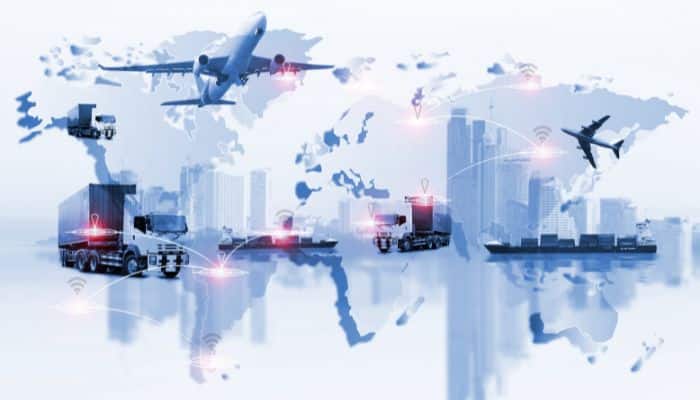17 Benefits Of Using Logistics Technology Solutions To Customers And Supply Chains
Whilst the growth of most industries has been underpinned by the rapid adoption of new technology, the shipping and logistics industry has been a notable exception in this regard.
Still adhering to processes and customs in vogue for decades, the shipping and logistics industry has been a laggard when it comes to implementing new technological solutions for automating workflows and digitising documentation.

This is, to a great extent, due to the global nature of the industry, spanning diverse jurisdictions and a multitude of stakeholders.
The sheer number of variations to the broad process of international transport poses considerable challenges in the industry-wide adoption of technology.
However, with the increasing geographical diversification of international trade and the growing sophistication of supply chains, customers are now holding their transport vendors accountable to higher standards of performance.
In order to optimise their own dispersed supply chains and streamline inventory management, big manufacturers and importers require shipping carriers and global freight forwarders to provide functionalities such as real-time shipment visibility, daily status reports, automated pre-alerts and information sharing, and digitised processes.
These evolving market requirements can be met only by the implementation of the latest software solutions which are designed specifically to cater to the shipping and logistics industry.
Further impetus to the imperative for digital transformation was provided post-2020 by the Covid-induced lockdowns and mobility restrictions, which quickly spiralled into port congestion across the globe and supply chain disruptions on unprecedented magnitude.
During that time, remote working necessitated automation and digitisation workflows, compelling corporates and government authorities to move away from manual paperwork-based tasks.
Moreover, the delays were so severe that manufacturers and retailers could not plan their supply chain and transportation schedules with any semblance of reliability. They, therefore, realised the value of real-time visibility to determine when cargo would actually reach the intended destination, which in turn would facilitate the planning of production schedules and inventory replenishment.
These challenges made transport service vendors more open to the concept of using technology, with a greater number of logtech vendors foraying into the market to fulfil this need.
Consequently, we have, over the past few years, seen a proliferation in the number of logistics technology solutions available in the market, offering varying levels of functionalities.
The game-changer in this regard has been the advancements in Artificial Intelligence (AI) and Machine Learning (ML), which have enabled the development of sophisticated logistics technology solutions aimed at the holistic transport process or specific aspects thereof.
Related reading:
10 Trends Expected To Define Supply Chains And Shipping In 2023
Benefits of logistics technology:
In this article, we will understand the benefits and advantages that accrue from the usage of technological solutions:
1. Reduction in manual effort:

With systems taking care of rote tasks, document processing and information sharing amongst various stakeholders, much manpower is saved. This manpower can be gainfully utilised for core business activities once the amount of paperwork and mundane tasks is reduced.
2. Higher accuracy:
When a process is handled manually, there always exists the risk of human errors, especially with repetitive tasks or complex procedures. When these activities are handled by systems, the probability of errors is negligible. This leads to higher accuracy levels and eliminates risks arising from errors of omission and commission.
3. Faster processing:

Since systems can process data faster than humans, another obvious benefit is the faster processing of data and completion of tasks. This leads to faster information sharing and minimises delays that could possibly arise from delayed submission of data to government departments and customs officials.
Customers also get earlier intimation about possible delays or contingencies or where certain specific actions (such as submitting some document or making corrections to paperwork submitted) are required.
4. Better compliance levels:
Technology helps ensure that all steps in the transport process are completed well in time, including document submissions and complying with applicable regulations. This negates the risks of penalties and delays in cases of non-adherence to procedures and regulations.
5. Cost savings:

The combination of faster data processing, greater accuracy levels and reduction in effort leads to considerable cost savings. Apart from the obvious savings from reduced manpower and time expended, savings also accrue from better planning and inventory management (which helps reduce overall transport costs and rationalising inventory holding costs).
6. Enhanced efficiency:
Due to better accuracy and access to high-quality data, companies can enhance their efficiency levels and boost the level of service offered to customers.
7. Higher data security levels:
With manual processes, there are always the risks of papers being lost or information being accessed by unauthorised persons. Technology can help overcome this aspect and boost data security, as the data is now stored in digital format (so no papers or hard copies lying around), access to which is generally restricted only to people authorised to access and view the data.

This aspect has recently gained considerable importance due to the increasing governmental focus on data security and the introduction of legislation obligating companies to take adequate care of data in their possession (with stiff monetary penalties and other strictures in case of failure to safeguard data security).
8. Timely alerts on various milestones in the shipping process:
With auto-generated pre-alerts, importers and exporters are made aware of actions that must be taken at each stage in the import process. This greatly helps importers to plan onward movement of goods or ensure compliance with regulations, as the case may be. Since the alerts are auto-generated by the system, there is no possibility of any notification not being shared.
9. Real-time visibility:
Customers are now aware of the advantages of real-time visibility of cargo location and status. Post-Covid, most customers now prefer relying on technology to be able to get real-time visibility on the status (and sometimes, condition) of their cargo.

This helps customers understand possible delays and other contingencies, for which they can prepare in advance or arrange timely evacuation and inland movement, even before the container has been discharged.
Visibility and status information can also help reduce detention and demurrage costs, as importers are aware of when the container will be discharged and can therefore make arrangements in advance for the immediate evacuation and de-stuffing of the container, well within the free time allowed by the carrier and port operator.
Related Reading:
How is Management of Empty Shipping Containers Carried Out?
10. Better supply chain planning:
All the above factors significantly improve the quality of supply chain planning, making the transport process more efficient and streamlined. Customers can plan better, reduce inventory levels, and avoid risks arising from failure to comply with applicable rules and regulations. Improvements in supply chain planning also permit smoother multimodal transport movement, with arrangements being made well in advance.
11. Better analytics and forecasting:
While the data generated in export and international transport transactions is massive, because it is not digitised or stored in one location, it is difficult for businesses to analyse the data and draw meaningful inferences therefrom.

Also, the vastness of the data renders it beyond human capacity to process and analyse all the data. With logtech software, however, all the data is digitised and saved centrally. After using the system’s superior computing power, businesses can analyse the data at the most granular level possible and glean analytical insights. Functionalities like predictive analytics take this a step further by identifying past patterns and suggesting recommended courses of action for the future.
Related reading:
What Are Container Tracking Systems?
12. Pre-empting possible contingencies and enabling better contingency planning:
Systems can combine data from a wide range of sources, covering the entire gamut of factors that can affect the movement of goods. An example is analysing weather forecasts along a vessel’s route to understand the impact of inclement weather on sailing schedules and possible delays. This is then highlighted as a possible risk factor, along with the probable extent of delays. The software can also help identify alternate routings that would be more appropriate under the given circumstances.
Such analysis helps a business pre-empt possible contingencies and take apt remedial actions or at least make contingency plans (such as increasing inventory levels to counter the impact of delayed deliveries or sourcing from different locations).
13. Seamless integration and co-ordination with stakeholders:

Since information sharing is automated and pre-alerts are sent to relevant stakeholders by the system itself, all parties are in timely possession of information that is necessary for them to perform their duties. Besides, with pre-alerts to remind them of upcoming tasks, the possibility of delayed action is minimised. Since this process is automated, the dependence of departments on each other for the sharing of information is reduced, and tasks are completed timely, which leads to smoother coordination amongst internal and external stakeholders.
14. Lower operational costs:
While the capital expenditure involved in deploying a logistics software solution is high, the subsequent cost savings lead to a significant lowering of operational costs. Companies can reduce headcount and reallocate human resources to high-value tasks, resulting in higher productivity.
15. Improved customer experience

The streamlining of logistics processes and tasks helps improve the functioning of the supply chain in terms of faster completion of customer orders, ready availability of inventory to fulfil orders, lower probability of stockouts, shorter delivery times, and proactive communication in case of delays and contingencies. The net result is a superior customer experience.
16. Competitive edge
The deployment of technology helps improve internal efficiency and customer satisfaction levels, which translates into a distinct competitive edge vis a vis competitors who still rely on outdated manual working modes. This competitive edge further translates into commercial advantages in the form of attracting new customers and gaining more business from existing customers.
17. Sustainability and Green Operations:

Using technology can help a carrier or logistics service provider make their operations eco-friendly and more sustainable in the following ways:
a) Minimise the use of paper by digitising documents
b) Optimise route planning by selecting shorter routes
c) Reduce bunker consumption by selecting the best routing options (regarding distance, weather conditions, maximising cargo picked up on the same voyage, better stowage planning, etc.)
d) compare and evaluate different products/alternatives to understand carbon impact and select the more eco-friendly option
Way forward for technology in maritime and logistics
Over the past few years, certain market leaders, such as the A.P Moller Group (in shipping and ports) and Kuehne and Nagel (in logistics and global freight forwarding), have made concerted efforts and invested heavily in developing technological solutions to improve internal efficiency and smoothen external co-ordination, while even mid-sized and smaller players have incorporated technology, primarily in their internal operations or specific aspects thereof.
These initiatives have, however, been restricted to the individual company’s internal sphere of operations rather than being at the wider or industry level.
In recent years, considering the increasing complexity of international business compounding the difficulties posed by the multiple myriad factors that need to be taken into account to optimise transport planning, shippers and global freight forwarders have been compelled to leverage technology to make their businesses more efficient and effective and decision-making more scientific.
As more and more companies harness the potential of technology, other companies see a clear business case for investing in technology (aside from the fear of missing out and falling behind the competition should they not adopt technology at a sufficiently early stage).
Also, since most shipping companies and freight forwarders rode the post-covid transportation demand boom and capitalised on record high freight rates, they are presently in a robust financial position, allowing them the latitude to take the long-term view and with sufficient cash reserves to invest in quality technological solutions.
Besides, with customers becoming increasingly more demanding, technology can be a source of competitive advantage and help carriers differentiate themselves in what is devolving into a highly commoditised industry.
Logtech solution providers, too, have been on a quest to constantly improve their products by incorporating the latest advancements in Artificial Intelligence (AI) and Machine Learning (ML).
The intensely competitive nature of the logtech market has also had the effect of democratising the logtech industry, where even small and medium-sized players can find technological solutions that are appropriate for their scale and budgets.
Therefore, it is highly likely that technology will become more prevalent in the maritime and logistics industry in the foreseeable future. With the rapid progress made in the fields of AI and ML, technological solutions will gain sophistication, providing reliable and affordable solutions that will boost their adoption even more.
In the long run, these technological solutions will steadily upend the existing ways of working and usher in a new era of tech-enabled supply chain planning and operations.
You might also like to read-
- Damaged Shipping Containers – Causes And Types
- What are Port Services?
- How is Management of Empty Shipping Containers Carried Out?
- Understanding International Waters: Boundaries, Jurisdiction And Legal Implications
- What is Nearshoring in Shipping And Logistics – Advantages and Disadvantages
Disclaimer: The authors’ views expressed in this article do not necessarily reflect the views of Marine Insight. Data and charts, if used in the article, have been sourced from available information and have not been authenticated by any statutory authority. The author and Marine Insight do not claim it to be accurate nor accept any responsibility for the same. The views constitute only the opinions and do not constitute any guidelines or recommendations on any course of action to be followed by the reader.
The article or images cannot be reproduced, copied, shared or used in any form without the permission of the author and Marine Insight.
Do you have info to share with us ? Suggest a correction

About Author
Jitendra has over 20 years of international experience in the Container Shipping, Ports and Logistics industry, spanning 3 diverse geographies, wherein he has been involved in the commercial and strategic aspects of the container business.
Latest Maritime law Articles You Would Like:
Latest News
- What are Logistics Risks?
- How Port and Terminal Operators Can Control Emissions?
- Minimum Quantity Commitment (MQC) and Liquidated Damages in Container Shipping: Concept and Relevance
- MARPOL (The International Convention for Prevention of Marine Pollution For Ships): The Ultimate Guide
- The Ultimate Shipping Container Dimensions Guide
- A Comprehensive Overview of IMDG Code for Shipping Dangerous Goods
Subscribe To Our Newsletters
By subscribing, you agree to our Privacy Policy and may receive occasional deal communications; you can unsubscribe anytime.
Web Stories




















